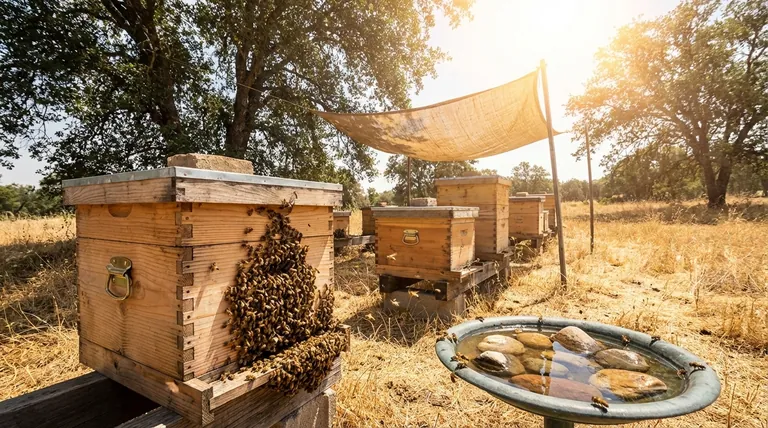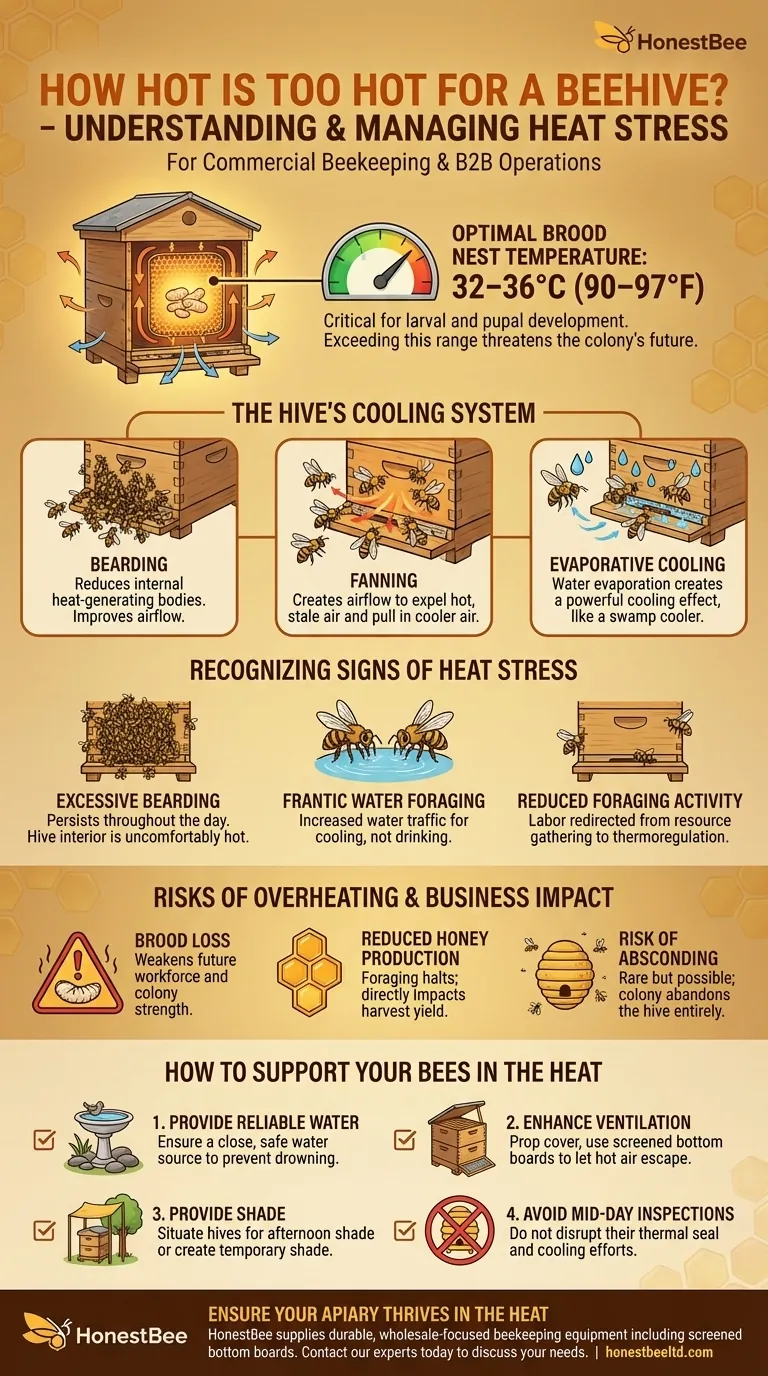In beekeeping, the critical temperature is not the air outside, but the temperature inside the brood nest, where the next generation of bees develops. Honey bees must maintain this area between 32–36°C (90–97°F). When the hive can no longer regulate its internal temperature and it rises above this range, the larvae and pupae begin to die, threatening the future of the entire colony.
The question isn't "what external temperature is too hot," but rather "at what point are my bees' natural cooling mechanisms overwhelmed?" Your primary role as a beekeeper during a heatwave is to support the colony's own remarkable ability to control its climate.

The Beehive's Climate Control System
A honey bee colony operates like a single, thermoregulating organism. It has evolved sophisticated strategies to maintain the stability of its core, the brood nest, against both extreme cold and extreme heat.
The Critical Brood Temperature
The 32–36°C (90–97°F) range is non-negotiable for the colony's survival. Within this narrow window, eggs, larvae, and pupae develop correctly.
Even a slight deviation above this temperature for a prolonged period can cause developmental defects or death, jeopardizing the workforce that will sustain the colony in the weeks and months to come.
How Bees Cool the Hive
When the internal temperature threatens to exceed the optimal range, worker bees initiate a series of coordinated cooling behaviors.
- Bearding: You will see a large number of bees congregate on the outside of the hive entrance. This reduces the number of heat-generating bodies inside and improves airflow.
- Fanning: Bees will line up at the entrance and throughout the hive, fanning their wings in unison. This creates a current of air, pushing hot, stale air out and pulling cooler, fresh air in.
- Evaporative Cooling: Forager bees will collect water, bring it back to the hive, and deposit tiny droplets on the honeycomb and other surfaces. The fanning bees then evaporate this water, creating a powerful cooling effect, much like a swamp cooler.
Recognizing Signs of Heat Stress
Observing your colony's behavior is the best way to gauge if they are coping with the heat or are under significant stress.
Excessive Bearding
A small "beard" of bees on the front of the hive on a warm evening is normal. However, a very large, dense beard that persists throughout the day is a clear sign that the hive's interior is uncomfortably hot.
Frantic Water Foraging
If you have a water source nearby, you will notice a dramatic increase in traffic. Bees will be urgently collecting water not for drinking, but as a critical component of their evaporative cooling system.
Reduced Foraging Activity
During peak heat, you may notice a sharp decline in bees foraging for nectar and pollen. The colony redirects its labor force from gathering resources to managing the internal temperature, which takes priority over all other tasks.
Understanding the Trade-offs and Risks
Failing to manage heat stress has direct consequences for hive health and productivity.
Brood Loss
This is the most severe risk. If the colony's cooling efforts fail and the brood nest overheats, you will lose a significant portion of your developing bees. This creates a population gap that can weaken the colony for weeks.
Reduced Honey Production
A colony focused entirely on thermoregulation is not a colony focused on honey production. Foraging comes to a standstill as bees are diverted to fanning and water collection, directly impacting your honey harvest.
Risk of Absconding
In very extreme and prolonged heat stress, a colony may determine the location is untenable and abscond, abandoning the hive entirely in search of a more suitable location. This is rare but possible in poorly managed situations.
How to Support Your Bees in the Heat
Your goal is not to cool the hive yourself, but to make it easier for the bees to do their job. Simple interventions can make a significant difference.
- If your primary focus is hydration: Ensure a reliable, close, and safe water source is available. A birdbath with stones or a bucket with floating corks prevents bees from drowning while they collect water.
- If your primary focus is ventilation: Prop the outer cover open slightly with a small stone or twig. This allows hot air to escape from the top of the hive, enhancing the bees' fanning efforts. A screened bottom board also provides excellent ventilation.
- If your primary focus is reducing sun exposure: Situate hives to receive morning sun but afternoon shade. If that's not possible, create temporary shade during a heatwave using a shade cloth, a large board, or even a patio umbrella.
- If your primary focus is avoiding unnecessary stress: Do not perform hive inspections during the hottest part of the day. Opening the hive breaks their thermal seal and disrupts their fanning and cooling efforts, doing more harm than good.
By understanding the colony's needs and providing simple support, you can help your bees navigate even the most intense summer heat.
Summary Table:
| Key Temperature Range | Primary Cooling Behaviors | Key Risks of Overheating |
|---|---|---|
| 32–36°C (90–97°F) | Bearding, Fanning, Evaporative Cooling | Brood Loss, Reduced Honey Production, Absconding |
Ensure your apiary thrives in the heat. HONESTBEE supplies durable beekeeping supplies and equipment designed to support large-scale operations. From screened bottom boards for better ventilation to essential hive components, our wholesale-focused solutions help commercial apiaries and distributors protect their valuable colonies. Contact our experts today to discuss your specific needs and keep your bees productive.
Visual Guide

Related Products
- Professional Grade Foldable Beehive Handles
- Premium Comfort Grip Spring-Loaded Hive Handles
- Professional Engraved Round Hive Number Tags for Beekeeping
- Professional Insulated Winter Hive Wrap for Beekeeping
- Black Plastic Beetle Barn Hive Beetle Trap for Beehives
People Also Ask
- When should the first inspection of a new hive be conducted? Ensure a Strong Start for Your Colony
- What month do honey bees come out? Understand Their Spring Emergence & Activity Cycle
- How can beekeepers remember the timeline of bee development from egg to pupa? Use the 3-6-12 Rule.
- What is a common hive setup in warmer regions? A Simple, Effective Guide for Healthy Bees
- What are some potential benefits of drones in a bee colony? Enhancing Hive Health and Productivity



















